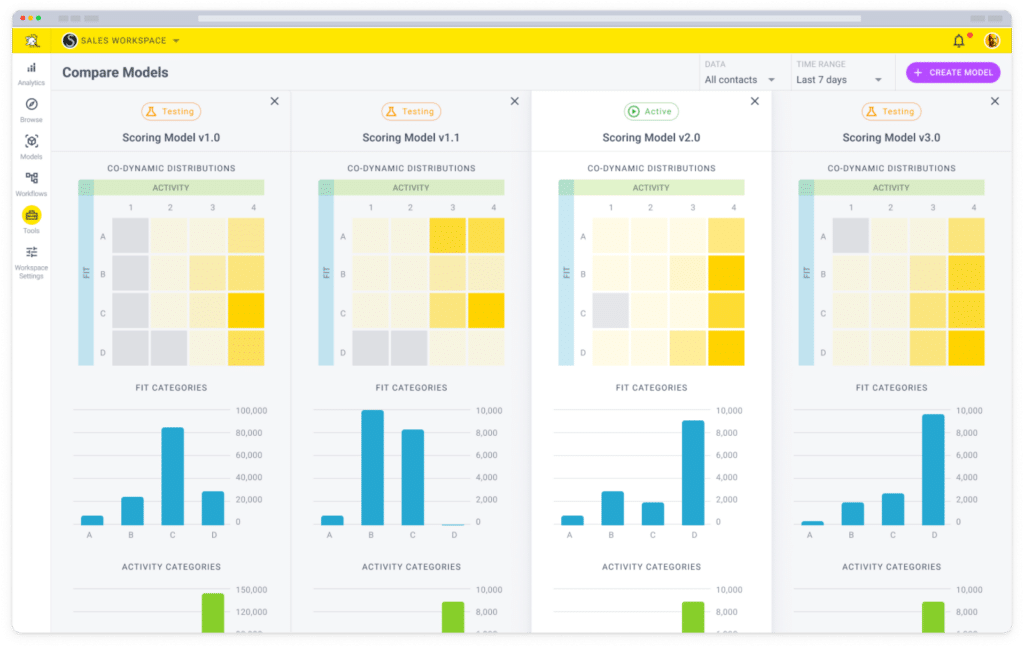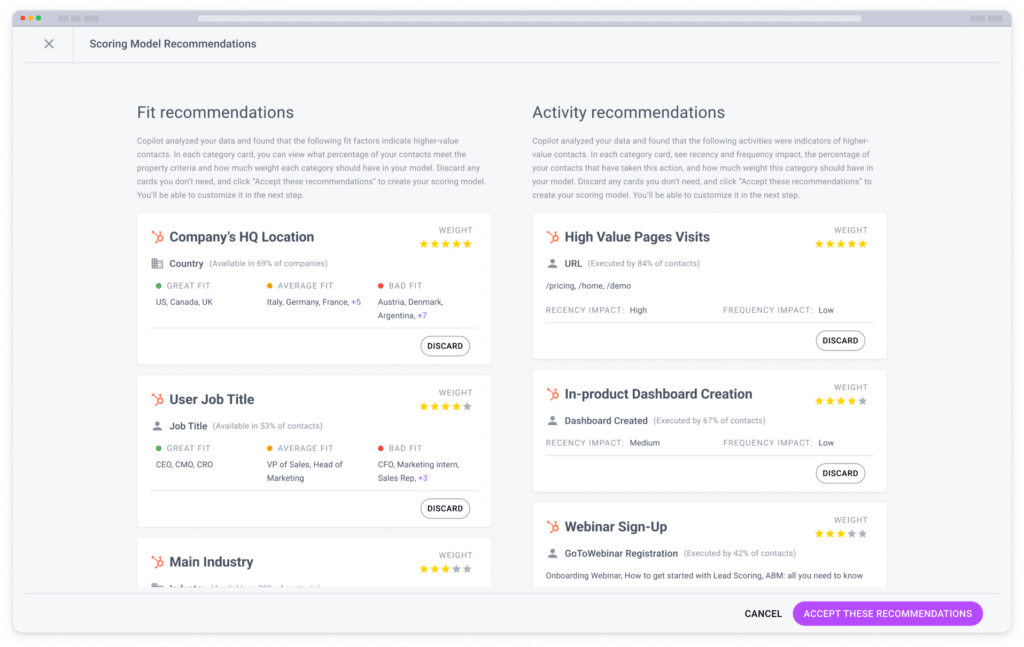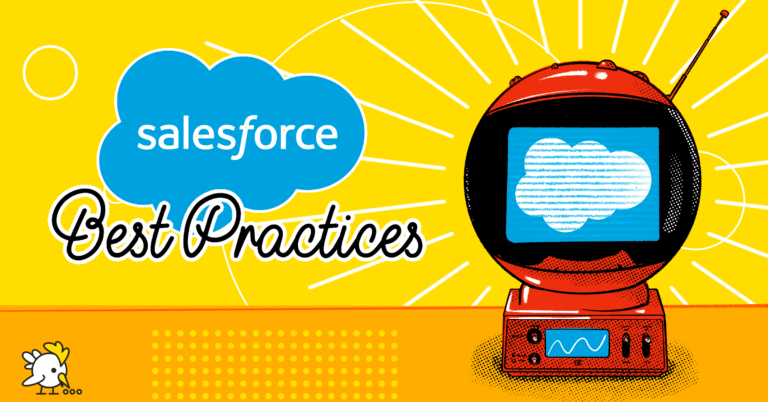Salesforce is one of the most high-powered sales and CRM-focused SaaS tools on the market today. It has exceptional features designed to help your team sell more, sell faster, and improve the customer experience, including customized opportunities, sales forecasting, and pipeline tracking.
One of those many features is lead scoring.
Salesforce has a solid lead scoring tool that helps brands identify potentially high-value clients or those more likely to convert so the team can strike quickly.
In this post, we’re going to go over everything you need to know about Salesforce’s lead scoring tool, including how it works, how to get the most out of it, and why you may want to consider other lead scoring tools.
How Does Salesforce’s Lead Scoring Tool Work?
Salesforce is a CRM and sales, service, and operations SaaS tool. Their CRM and sales features are all intertwined, and their contact scoring tool is included in that.
Salesforce’s traditional lead scoring tool had a default scoring model that was based entirely on activity. This default scoring system could be customized through Salesforce’s Marketing Account Engagement.

Right now, though, Salesforce’s main focus when it comes to lead scoring is their Einstein feature. Einstein is a collection of artificial intelligence (AI) tech and functionality built into Salesforce’s platform.
Their Einstein lead scoring feature specifically uses data science and machine learning to analyze your leads and look for patterns that may indicate a higher likelihood of conversion. Using the most information available in lead fields, they try to see which leads currently in your pipeline have the most in common with customers who have converted in the past.

In addition to analysis of lead potential based on existing data, Einstein is also capable of using AI to establish context for its scoring system.
It may create categories, for example, that similar job titles may fall into, allowing the system to assess conversion potential more effectively without getting lost in technical details, like one lead having the job title “RevOps Strategist” and another having the title “RevOps Manager.”
Overall, it’s a relatively simple-to-use tool, especially if you’re already a Salesforce customer with qualifying plans.
According to this article, Einstein lead scoring is available through the following plans, though some require additional purchases for the features:
- Lighting Experience
- Salesforce Classic
- Sales Cloud Einstein
Einstein Lead Scoring vs. Einstein Opportunity Scoring: What’s the Difference?
When you’re viewing Salescloud’s Einstein products, you’ll likely notice that there are two different “scoring” products through Einstein: lead scoring and opportunity scoring.
Lead scoring, as we’ve already established, provides scores for individual leads that can indicate the assessed likelihood of conversion based on the conversions of past customers.
Opportunity scoring, on the other hand, uses predictive forecasting about opportunities overall to assess which are most likely to close and for what value. It tracks opportunities based on stages in the sales process, and each opportunity is given a score between 1 and 99.

4 Tips to Get the Most Out of Salesforce’s Lead Scoring Tool
If you’re using Salesforce’s lead scoring tool (or if you’re planning on it), it’s essential to know how to use it strategically so that you’re getting the most accurate contact score possible, giving your team more accurate and reliable information.
As experts in lead scoring, these are the four essential Salesforce lead scoring tips we’ve got in our arsenal.
1. Prioritize The Right Lead Attributes
The lead attributes that are important for an AI copywriting tool likely won’t be the same as the attributes that matter most for an appointment-booking tool designed for small businesses. There’s no one size fits all, so it’s essential to keep that in mind.
Salesforce will not automatically know which lead qualities indicate a high-value client or a client who is most likely to convert; you’ll need to tell them.
Take the time to look through your customer profiles and data. Which attributes are the most important indicators for your brand?
Once you identify the core attributes that should be weighted more heavily, you can set up formula fields in SFDC where your lead information is stored. This can help give more weight to (and identify) specific values and output an accurate numeric score.
2. Use Data Stored On Related Objects
You can store data on different objects in Salesforce.
One of our best Salesforce lead scoring tips is to use data stored on related objects when scoring another relevant object. This allows you to increase the number of data points that you can score overall (e.g., combining customer interaction data from Salesforce to Snowflake).
The more data points, the better, as it gives you a more holistic look at a client (and thus a more accurate score).
3. Set Up Field History Tracking
Current lead data is great, but the ability to track lead scores over time can be enormously valuable, too. It can help you track changes over time and may even be able to help you look back and troubleshoot why you might be having certain types of leads drop off instead of converting.
In Salesforce, set up Field History Tracking on your score field. This will give you some basic history reporting regarding your contacts, allowing you to see simple historical trends of scores. While it doesn’t dive incredibly deep, having the basic information is a good place to start.
4. Set Up Automated Actions
Automation can be a game-changer for busy sales teams trying to manage a solid list of leads simultaneously. It can ensure that nothing is missed, and Salesforce has exceptional automation features that you can take advantage of.
Look at contact scoring automation. Within Salesforce, you can set triggered actions to occur when certain scoring thresholds are met for individual leads, including the following:
- Re-assign leads to different departments or sales team members
- Send notifications to alert your team of the change
- Automatically create an opportunity (or deal) to help convert the customer
You’ll want to consider which actions are most beneficial at different thresholds. For example, it may be beneficial to send a notification to alert your team when a lead score drops and automatically create an opportunity for specific leads once they reach a threshold of 80 or more (or whatever that number would be for you).
-
What Is Lead Scoring?
Read more: What Is Lead Scoring?Lead scoring is the method of assigning points to contacts or potential prospects based on…
-
What is BANT?
Read more: What is BANT?BANT is an acronym that stands for Budget, Authority, Need, and Timeline. It is a…
-
What is lead qualification?
Read more: What is lead qualification?Lead qualification is a systematic process utilized by businesses to evaluate potential customers based on…
Why SaaS Brands Feel Salesforce Falls Short
We’re huge fans of Salesforce as a CRM, sales, and marketing automation tool. It’s one of the most popular on the market—and for good reason.
That being said, an increasing number of businesses feel that the Salesforce lead scoring options fall short compared to what they need, which is why they turn to dedicated third-party lead scoring tools like Breadcrumbs.
It’s important to note that while native lead scoring tools like Salesforce’s can be helpful when it’s all in one dashboard, Salesforce’s lead scoring tool is relatively limited in a way that can impact the accuracy and actionability of your lead scoring data.
For example, you can customize the Einstein scoring model, but you can’t create multiple models to split test or target users for different sales processes, like cross-selling or upselling.
It’s good baseline information, but for brands whose sales teams are looking for deeply actionable data that they can use to increase pipeline volume and velocity, dedicated platforms like Breadcrumbs are the way to go.
How Breadcrumbs’ Lead Scoring Can Help Salesforce Customers
Breadcrumbs is a dedicated lead scoring tool that will knock most “native” lead scoring features on other major platforms out of the water.
And good news for Salesforce customers: We’ll integrate directly with Salesforce, sync your data to our platform, and leverage Salesforce’s high-powered CRM data with our powerful and fully-customizable lead scoring software to give you more actionable and accurate lead scoring data than ever before.
Breadcrumbs, unlike other tools, uses a co-dynamic lead scoring system. Each lead receives an alpha-numeric score, like A1 or B4, to help you truly understand how a potential lead fits into your bigger picture. All of this is available in a dedicated dashboard, with analytics designed exclusively for lead scoring purposes.

And again, unlike most tools, we look at the entire profile of a lead when calculating their scores. We consider both firmographic fit and lead activity, giving you insight into ICP alignment and actual lead engagement because both matter.
We also consider the recency and frequency of actions taken, ensuring your data is always up-to-date so your sales teams can prioritize high-value leads when they’re actively hot.
While we can offer suggestions for lead scoring models based on your business data, these models are fully customizable and testable—all on your own, no middleman required.

Create multiple split-tests to determine how different lead scoring criteria impact the accuracy of the scores themselves. Then, create models so that your team can identify not only new potential customers but also cross-selling, upselling, and even churn opportunities.
But What if I Love Einstein’s AI Potential?
If you’re interested in Salesforce’s Einstein lead scoring tool because it seems relatively hands-off and automated, we hear you; more automation can be appealing, especially if you aren’t sure exactly where to start with lead scoring and you feel overwhelmed with what seems like too many data points.
That’s why we created Breadcrumbs’ Copilot.

Breadcrumbs’ Copilot is an AI-driven lead scoring wizard, capable of creating custom-to-your-business lead scoring models in just a few seconds, and just a few clicks.
Our AI and machine learning Copilot will help you to analyze all of your data to generate lead scoring models based on past and current audiences. We’ll show you which specific fit and activity recommendations we think you should focus on and how we recommend you score them. But here’s the good news: You stay in complete control of these models, adjusting variables as you see fit.
And that’s how AI should ultimately be used in sales and marketing (and that’s true for AI in web development as well): A way to cut through the data for a quick but thorough analysis, all while keeping knowledgeable humans who know their audience best in the driver’s seat.
Use Copilot to build advanced custom scoring models, assign scores based on ICP alignment, engagement, and purchasing potential. You can also use it to refine existing scoring systems, or implement split tests, especially alongside evolving business goals, market dynamics, and audience changes.
-
Lead Scoring vs Lead Nurturing: 7 Differences to Maximize Your Sales Funnel
Read more: Lead Scoring vs Lead Nurturing: 7 Differences to Maximize Your Sales FunnelManaging leads effectively means prospects move through the funnel efficiently, resulting in more conversions and…
Final Thoughts
Salesforce is an outstanding lead scoring tool, and its best use is to help you assess leads to identify those most likely to become clients.
Breadcrumbs goes beyond that. We can help with customer acquisition, conversion, retention, and expansion. We don’t want to just help you land new customers, we want to help you build stronger relationships and sell more to them for longer. That’s the secret to true revenue acceleration.
Our models that take fit and activity into account (along with frequency and time-decay factored into the equation) can give you an up-to-date look at any of your contacts at any point in time, making it easier for your sales and customer success teams to do their job well.
Ready to take your lead scoring to the next level? Book your free demo with Breadcrumbs today.



